A Synchrotron Radiation Photoemission Study of SiGe(001)-2×1 Grown on Ge and Si Substrates: The Surface Electronic Structure for Various Ge Concentrations
Abstract
1. Introduction
2. Experimental Section
2.1. Sample Preparations, Surface Structure, and Morphological Characterization
2.2. Data Analysis
3. Results and Discussion
3.1. Valence Band Spectra of SiGe Alloys
3.2. General Analysis of Core-Level Spectra
3.3. Specifics for Ge 3d Core-Level Spectra
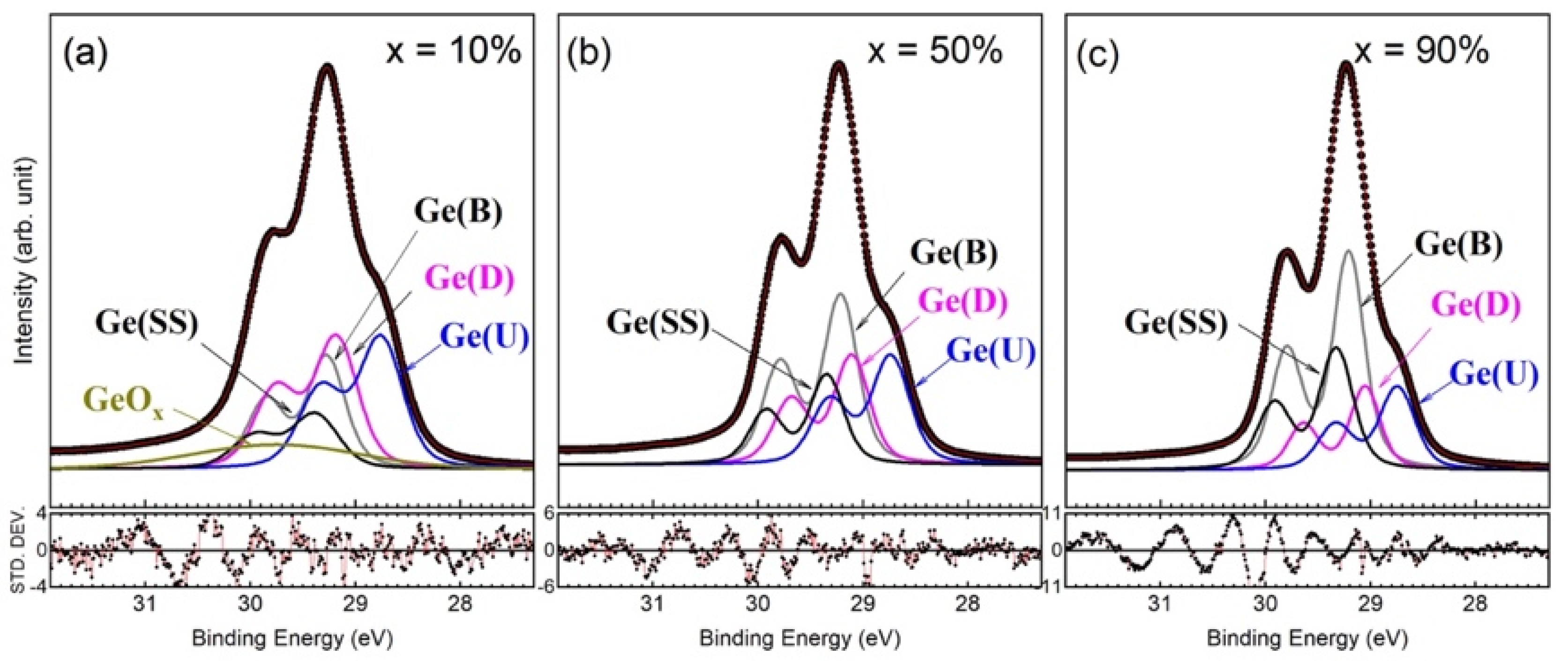
| x = 10% | x = 30% | x = 50% | x = 70% [21] | x = 90% | epi Ge(001) | |
|---|---|---|---|---|---|---|
| Ge 3d | ||||||
| SCLS of Ge(SS) | +0.106 | +0.100 | +0.132 | +0.110 | +0.118 | +0.101 |
| SCLS of Ge(U) | −0.519 | −0.523 | −0.476 | −0.464 | −0.463 | −0.468 |
| SCLS Ge(D) | −0.094 | −0.130 | −0.105 | −0.142 | −0.157 | −0.090 |
| Δ(Ge(U)-Ge(D)) | 0.425 | 0.393 | 0.371 | 0.322 | 0.306 | 0.378 |
| % Area (Ge(B)) | 21% | 28% | 34% | 40% | 41% | 46% |
| Si 2p | ||||||
| Δ(Si(S)’-Si(B)) | 0.170 | 0.168 | 0.144 | 0.187 | 0.178 | |
| Δ(Si(S)”-Si(B)) | 0.128 | 0.123 | 0.135 | 0.143 | 0.197 | |
| % Area (Si(B)) | 48% | 41% | 55% | 61% | 61% |
3.4. Specifics for Si 2p Core-Level Spectra
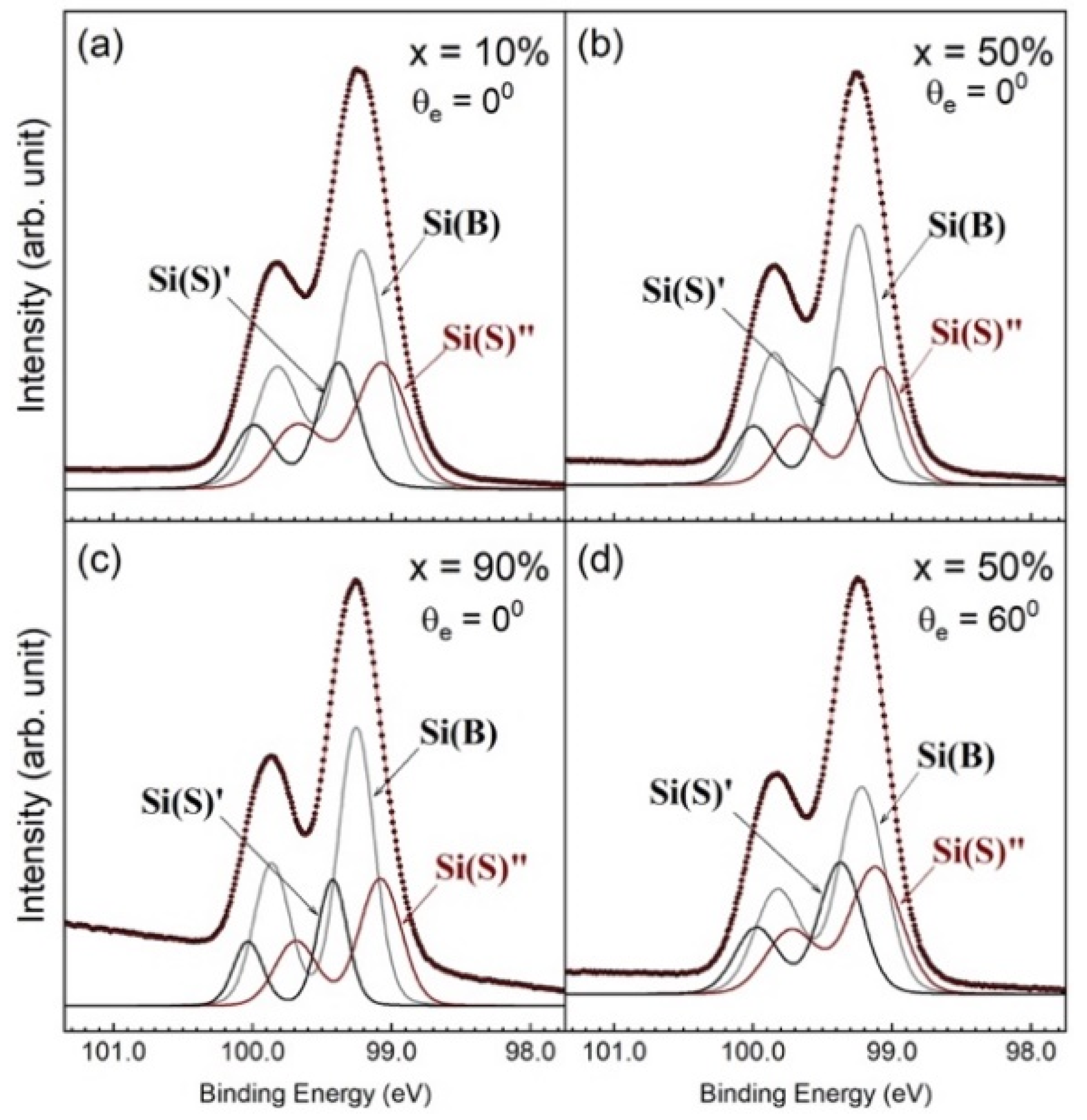
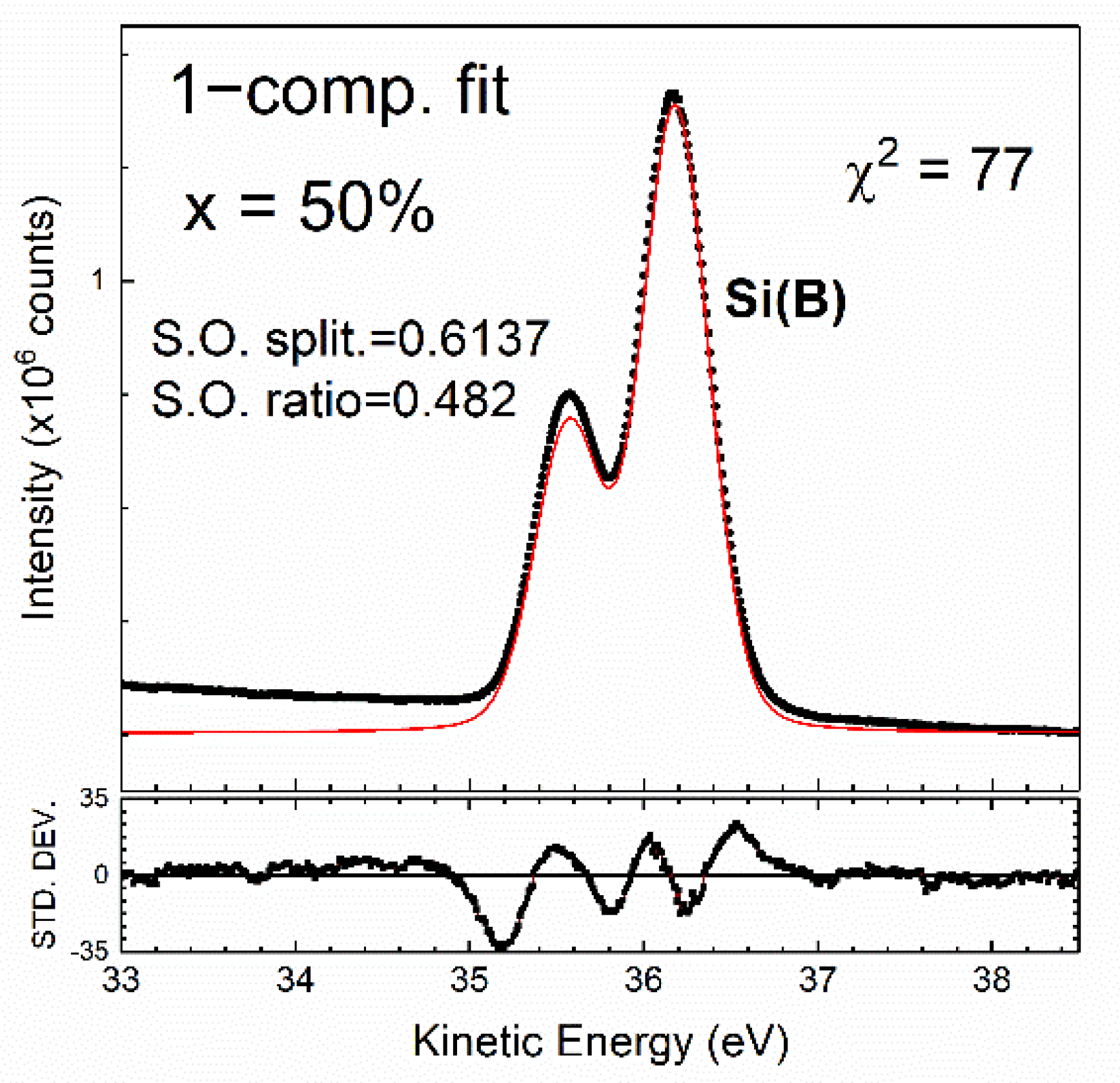
3.5. SiGe(001)-2×1 Grown on a Si Substrate
4. Conclusions
Author Contributions
Funding
Institutional Review Board Statement
Informed Consent Statement
Data Availability Statement
Conflicts of Interest
References
- Yeap, G.; Lin, S.S.; Chen, Y.M.; Shang, H.L.; Wang, P.W.; Lin, H.C.; Peng, Y.C.; Sheu, J.Y.; Wang, M.; Chen, X.; et al. 5 nm CMOS Production Technology Platform featuring full-fledged EUV, and High Mobility Channel FinFETs with densest 0.021 µm2 SRAM cells for Mobile SoC and High Performance Computing Applications. In Proceedings of the 2019 IEEE International Electron Devices Meeting (IEDM), San Francisco, CA, USA, 7–11 December 2019; Volume 879. [Google Scholar]
- Takagi, S.; Zhang, R.; Suh, J.; Kim, S.-H.; Yokoyama, M.; Nishi, K.; Takenaka, M. III–V/Ge channel MOS device technologies in nano CMOS era. Jpn. J. Appl. Phys. 2015, 54, 06FA01. [Google Scholar] [CrossRef]
- Fu, C.H.; Lin, Y.H.; Lee, W.C.; Lin, T.D.; Chu, R.L.; Chu, L.K.; Chang, P.; Chen, M.H.; Hsueh, W.J.; Chen, S.H.; et al. Self-aligned inversion-channel n-InGaAs, p-GaSb, and p-Ge MOSFETs with a common high κ gate dielectric using a CMOS compatible process. Microelectron. Eng. 2015, 147, 330–334. [Google Scholar] [CrossRef]
- Zhang, R.; Iwasaki, T.; Taoka, N.; Takenaka, M.; Takagi, S. Al2O3/GeOx/Ge gate stacks with low interface trap density fabricated by electron cyclotron resonance plasma postoxidation. Appl. Phys. Lett. 2011, 98, 112902. [Google Scholar] [CrossRef]
- Toriumi, A.; Nishimura, T. Germanium CMOS potential from material and process perspectives: Be more positive about germanium. Jpn. J. Appl. Phys. 2018, 57, 010101. [Google Scholar] [CrossRef]
- Delabie, A.; Bellenger, F.; Houssa, M.; Conard, T.; Van Elshocht, S.; Caymax, M.; Heyns, M.; Meuris, M. Effective electrical passivation of Ge(100) for high-k gate dielectric layers using germanium oxide. Appl. Phys. Lett. 2007, 91, 082904. [Google Scholar] [CrossRef]
- Lin, C.A.; Lin, H.C.; Chiang, T.H.; Chu, R.L.; Chu, L.K.; Lin, T.D.; Chang, Y.C.; Wang, W.-E.; Kwo, J.; Hong, M. Achieving a Low Interfacial Density of States with a Flat Distribution in High-κ Ga2O3(Gd2O3) Directly Deposited on Ge. Appl. Phys. Express 2011, 4, 111101. [Google Scholar] [CrossRef]
- Zhang, R.; Huang, P.-C.; Lin, J.-C.; Taoka, N.; Takenaka, M.; Takagi, S. High-Mobility Ge p- and n-MOSFETs With 0.7-nm EOT Using HfO2/Al2O3/GeOx/Ge Gate Stacks Fabricated by Plasma Postoxidation. IEEE Trans. Electron. Devices 2013, 60, 927–934. [Google Scholar] [CrossRef]
- Franco, J.; Kaczer, B.; Roussel, P.J.; Mitard, J.; Sioncke, S.; Witters, L.; Mertens, H.; Grasser, T.; Groeseneken, G. Understanding the suppressed charge trapping in relaxed- and strained-Ge/SiO2/HfO2 pMOSFETs and implications for the screening of alternative high-mobility substrate/dielectric CMOS gate stacks. In Proceedings of the 2013 IEEE International Electron Devices Meeting (IEDM), Washington, DC, USA, 9–11 December 2013. [Google Scholar]
- Chu, T.-Y.; Wan, H.-W.; Cheng, Y.-T.; Cheng, C.-K.; Hong, Y.-J.; Kwo, J.; Hong, M. In-situ deposited HfO2 and Y2O3 on epi-Si/p-Ge—A comparative study of the interfacial properties and reliability. Jpn. J. Appl. Phys. 2022, 61, SC1074. [Google Scholar] [CrossRef]
- Kevan, S.D. Surface states and reconstruction on Ge(001). Phys. Rev. B Condens. Matter. 1985, 32, 2344–2350. [Google Scholar] [CrossRef]
- Landemark, E.; Karlsson, C.J.; Chao, Y.C.; Uhrberg, R.I.G. Core-level spectroscopy of the clean Si(001) surface: Charge transfer within asymmetric dimers of the 2×1 and c(4×2) reconstructions. Phys. Rev. Lett. 1992, 69, 1588–1591. [Google Scholar] [CrossRef]
- Pehlke, E.; Scheffler, M. Evidence for site-sensitive screening of core holes at the Si and Ge (001) surface. Phys. Rev. Lett. 1993, 71, 2338–2341. [Google Scholar] [CrossRef]
- Pi, T.W.; Hong, I.H.; Cheng, C.P.; Wertheim, G.K. Surface photoemission from Si(100) and inelastic electron mean-free-path in silicon. J. Electron Spectrosc. Relat. Phenom. 2000, 107, 163–176. [Google Scholar] [CrossRef]
- Radny, M.W.; Shah, G.A.; Schofield, S.R.; Smith, P.V.; Curson, N.J. Valence surface electronic states on Ge(001). Phys. Rev. Lett. 2008, 100, 246807. [Google Scholar] [CrossRef] [PubMed]
- Chu, L.K.; Lin, T.D.; Huang, M.L.; Chu, R.L.; Chang, C.C.; Kwo, J.; Hong, M. Ga2O3(Gd2O3) on Ge without interfacial layers: Energy-band parameters and metal oxide semiconductor devices. Appl. Phys. Lett. 2009, 94, 202108. [Google Scholar] [CrossRef]
- Eriksson, P.E.J.; Uhrberg, R.I.G. Surface core-level shifts on clean Si(001) and Ge(001) studied with photoelectron spectroscopy and density functional theory calculations. Phys. Rev. B 2010, 81, 125443. [Google Scholar] [CrossRef]
- Cheng, Y.T.; Lin, Y.H.; Chen, W.S.; Lin, K.Y.; Wan, H.W.; Cheng, C.-P.; Cheng, H.H.; Kwo, J.; Hong, M.; Pi, T.W. Surface electronic structure of epi Germanium (001)-2×1. Appl. Phys. Express 2017, 10, 075701. [Google Scholar] [CrossRef]
- Pi, T.W.; Cheng, C.P.; Wertheim, G.K. The reaction of Si(001)-2×1 with magnasium. J. Appl. Phys. 2011, 109, 043701. [Google Scholar]
- Koh, H.; Kim, J.W.; Choi, W.H.; Yeom, H.W. Reinvestigation of the Si 2p photoemission line shape from a clean Si(001)c(4x2) surface. Phys. Rev. B 2003, 67, 073306. [Google Scholar] [CrossRef]
- Cheng, Y.T.; Wan, H.W.; Cheng, C.K.; Cheng, C.-P.; Kwo, J.; Hong, M.; Pi, T.W. Surface electronic structure of Si1−xGex(001)-2×1: A synchrotron radiation photoemission study. Appl. Phys. Express 2020, 13, 095503. [Google Scholar] [CrossRef]
- Wan, H.-W.; Hong, Y.-J.; Cheng, Y.-T.; Cheng, C.-K.; Hsu, C.-H.; Wu, C.-T.; Pi, T.-W.; Kwo, J.; Hong, M. Low-Temperature-Grown Single-Crystal Si Epitaxially on Ge, Followed by Direct Deposition of High-κ Dielectrics–Attainment of Low Interfacial Traps and Highly Reliable Ge MOS. ACS Appl. Electron. Mater. 2021, 3, 2164–2169. [Google Scholar] [CrossRef]
- Lin, K.Y.; Wan, H.W.; Chen, K.H.M.; Fanchiang, Y.T.; Chen, W.S.; Lin, Y.H.; Cheng, Y.T.; Chen, C.C.; Lin, H.Y.; Young, L.B.; et al. Molecular beam epitaxy, atomic layer deposition, and multiple functions connected via ultra-high vacuum. J. Cryst. Growth 2019, 512, 223–229. [Google Scholar] [CrossRef]
- Butz, R.; Kampers, S. 2×n surface structure of SiGe layers deposited on Si(100). Appl. Phys. Lett. 1992, 61, 1307–1309. [Google Scholar] [CrossRef]
- Cheng, Y.T.; Wan, H.W.; Cheng, C.-P.; Kwo, J.; Hong, M.; Pi, T.W. Atom-to-atom interaction of O2 with epi Ge(001)-2×1 in elucidating GeOx formation. Appl. Phys. Express 2018, 11, 115701. [Google Scholar] [CrossRef]
- Cheng, Y.T.; Wan, H.W.; Cheng, C.-P.; Kwo, J.; Hong, M.; Pi, T.W. Microscopic views of atomic and molecular oxygen bonding with epi Ge(001)-2×1 studied by high-resolution synchrotron radiation photoemission. Nanomaterials 2019, 9, 554. [Google Scholar] [CrossRef]
- Pi, T.W.; Lin, H.Y.; Chiang, T.H.; Liu, Y.T.; Chang, Y.C.; Lin, T.D.; Wertheim, G.K.; Kwo, J.; Hong, M. Surface atoms core-level shifts in single crystal GaAs surfaces: Interactions with trimethylaluminum and water prepared by atomic layer deposition. Appl. Surf. Sci. 2013, 284, 601–610. [Google Scholar] [CrossRef]
- Pi, T.W.; Lin, H.Y.; Liu, Y.T.; Lin, T.D.; Wertheim, G.K.; Kwo, J.; Hong, M. Atom-to-atom interactions for atomic layer deposition of trimethylaluminum on Ga-rich GaAs(001)-4x6 and As-rich GaAs(001)-2x4 surfaces: A synchrotron-radiation photoemission study. Nanoscale Res. Lett. 2013, 8, 169. [Google Scholar] [CrossRef] [PubMed]
- Pi, T.W.; Lin, T.D.; Chang, W.H.; Chang, Y.C.; Kwo, J.; Hong, M. Semiconductor-insulator interfaces—High k dielectrics on (In)GaAs. In Wiley Encyclopedia of Electrical and Electronics Engineering; Wiley: Hoboken, NJ, USA, 2014. [Google Scholar]
- Pi, T.W.; Chen, W.S.; Lin, Y.H.; Cheng, Y.T.; Wei, G.J.; Lin, K.Y.; Cheng, C.-P.; Kwo, J.; Hong, M. Relevance of GaAs(001) surface electronic structure for high frequency dispersion on n-type accumulation capacitance. Appl. Phys. Lett. 2017, 110, 052107. [Google Scholar]
- Mönch, W. Semiconductor Surfaces and Interfaces; Springer: Berlin, Germany, 2007. [Google Scholar]
- Rowe, J.E.; Riffe, D.M.; Wertheim, G.K.; Bean, J.C. Photoemission measurement of equilibrium segregation at GeSi Surfaces. J. Appl. Phys. 1994, 76, 4915–4917. [Google Scholar] [CrossRef][Green Version]
- Fukatsu, S.; Fujita, K.; Yaguchi, H.; Shiraki, Y.; Ito, R. Self-limitation in the surface segregation of Ge atoms during Si molecular beam epitaxial growth. Appl. Phys. Lett. 1991, 59, 2103–2105. [Google Scholar] [CrossRef]
- Floro, J.A.; Chason, E. Measuring Ge segregation by real-time stress monitoring during Si1−xGex molecular beam epitaxy. Appl. Phys. Lett. 1996, 69, 3830–3832. [Google Scholar] [CrossRef]
- Bogusławski, P.; Bernholc, J. Surface Segregation of Ge at SiGe(001) by Concerted Exchange Pathways. Phys. Rev. Lett. 2002, 88, 166101. [Google Scholar] [CrossRef] [PubMed]
- Cheng, Y.T.; Chen, W.S.; Cheng, C.K.; Cheng, C.-P.; Kwo, J.; Hong, M.; Pi, T.W. Low-temperature grown single-crystal Si on epi Ge(001)-2×1 and its oxidation: Electronic structure study via synchrotron radiation photoemission. Appl. Phys. Express 2020, 13, 085504. [Google Scholar] [CrossRef]
- Liu, F.; Lagally, M.G. Interplay of stress, structure, and stoichiometry in Ge-covered Si(001). Phys. Rev. Lett. 1996, 76, 3156–3159. [Google Scholar] [CrossRef] [PubMed]
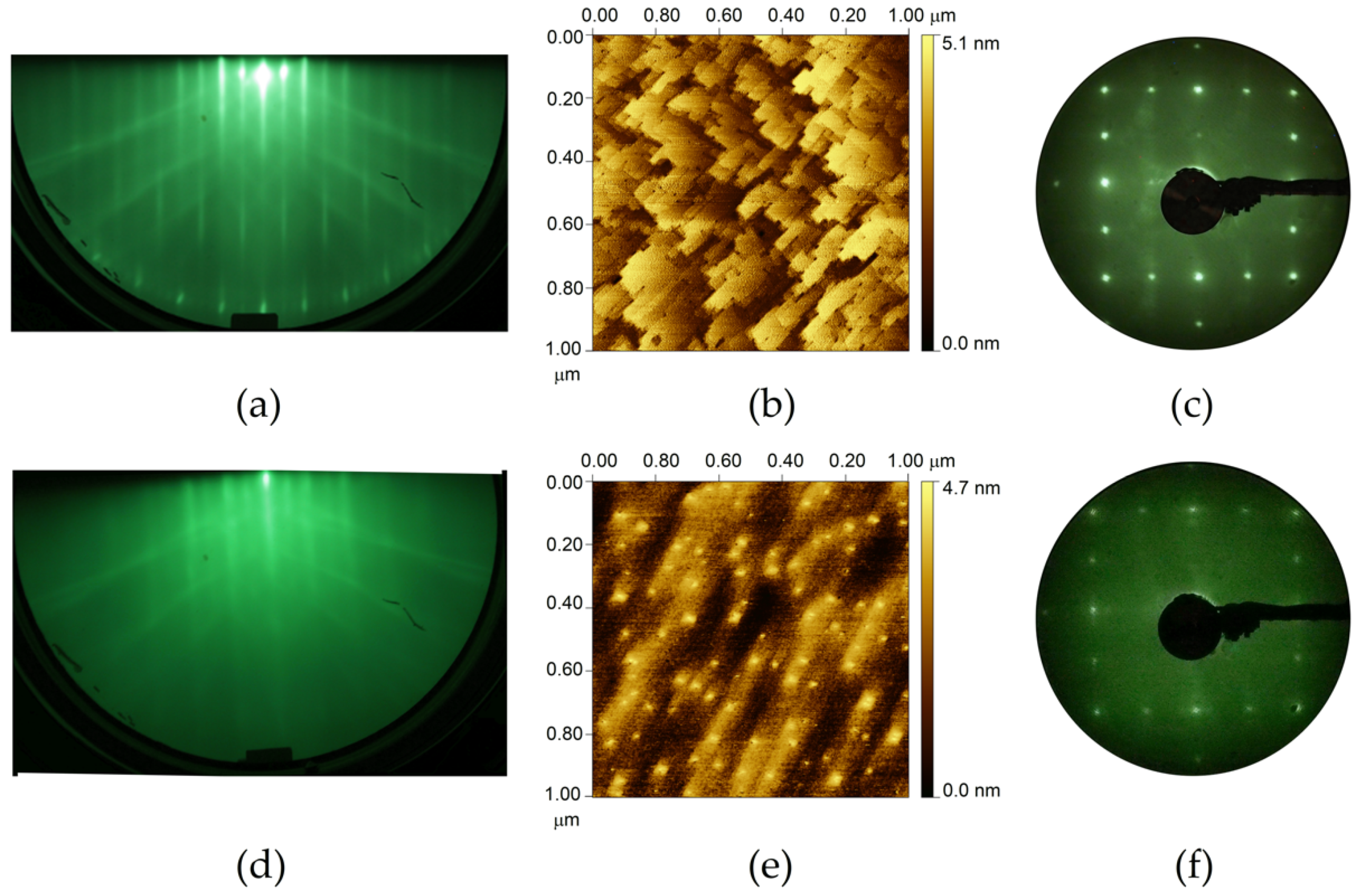
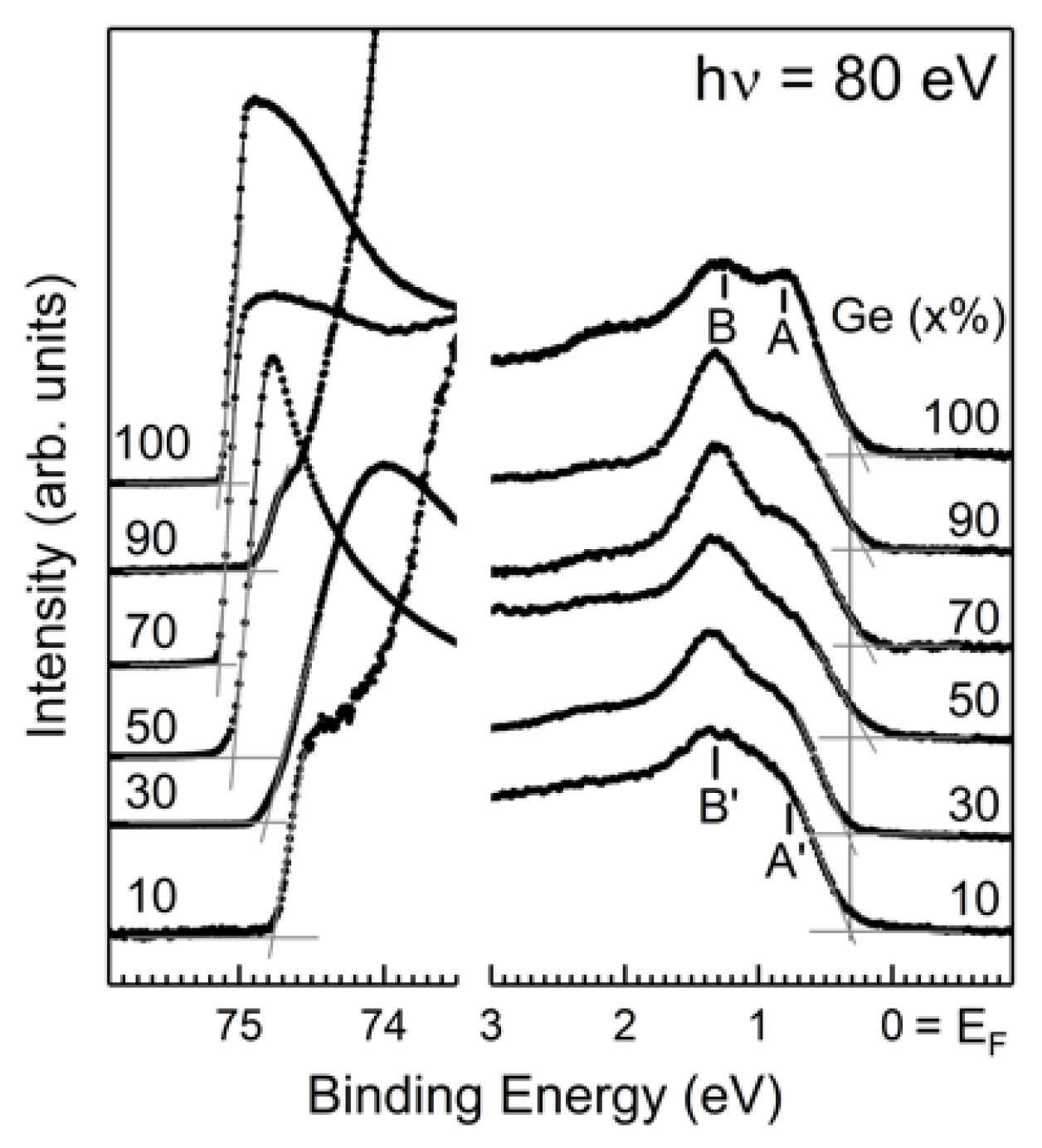
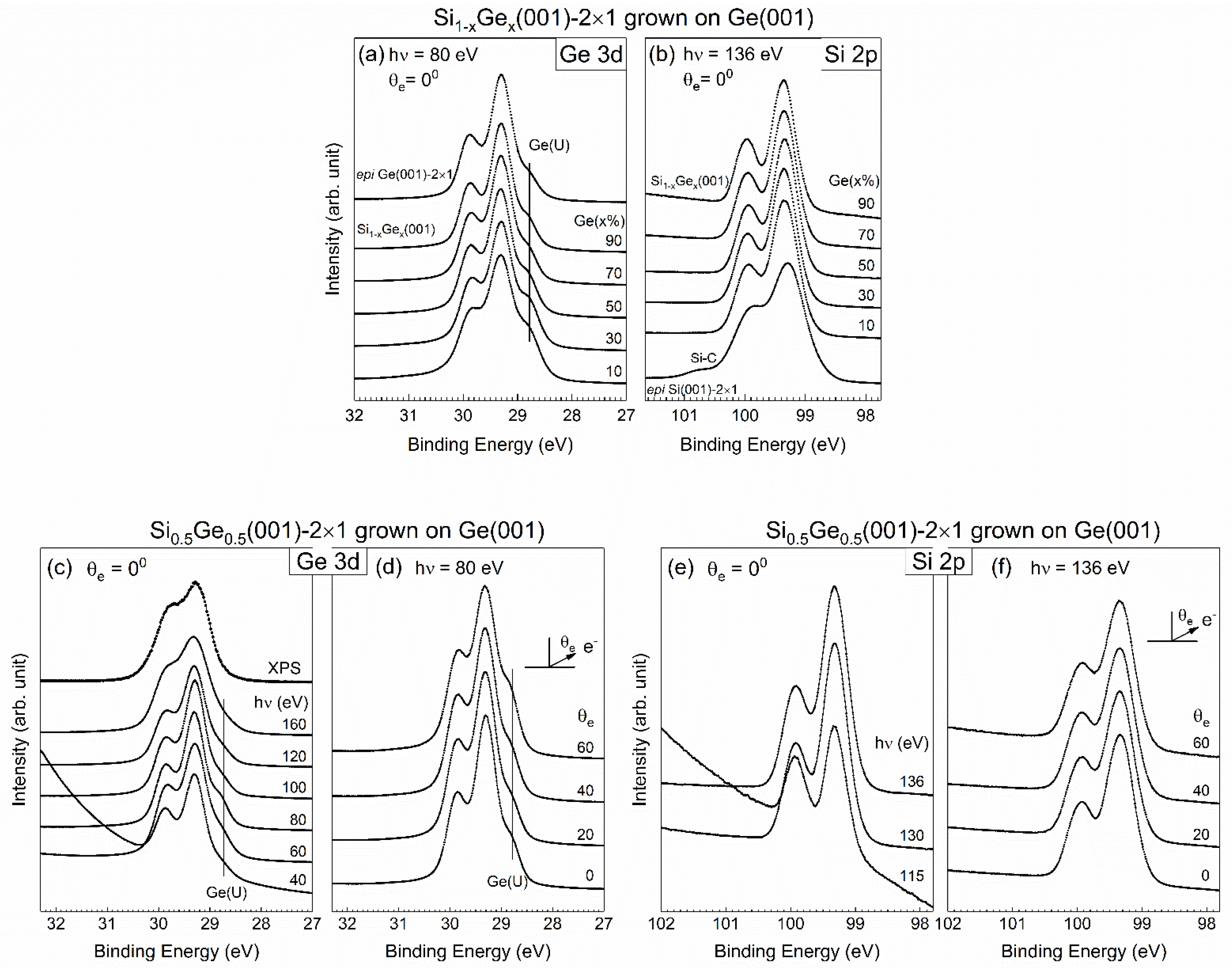

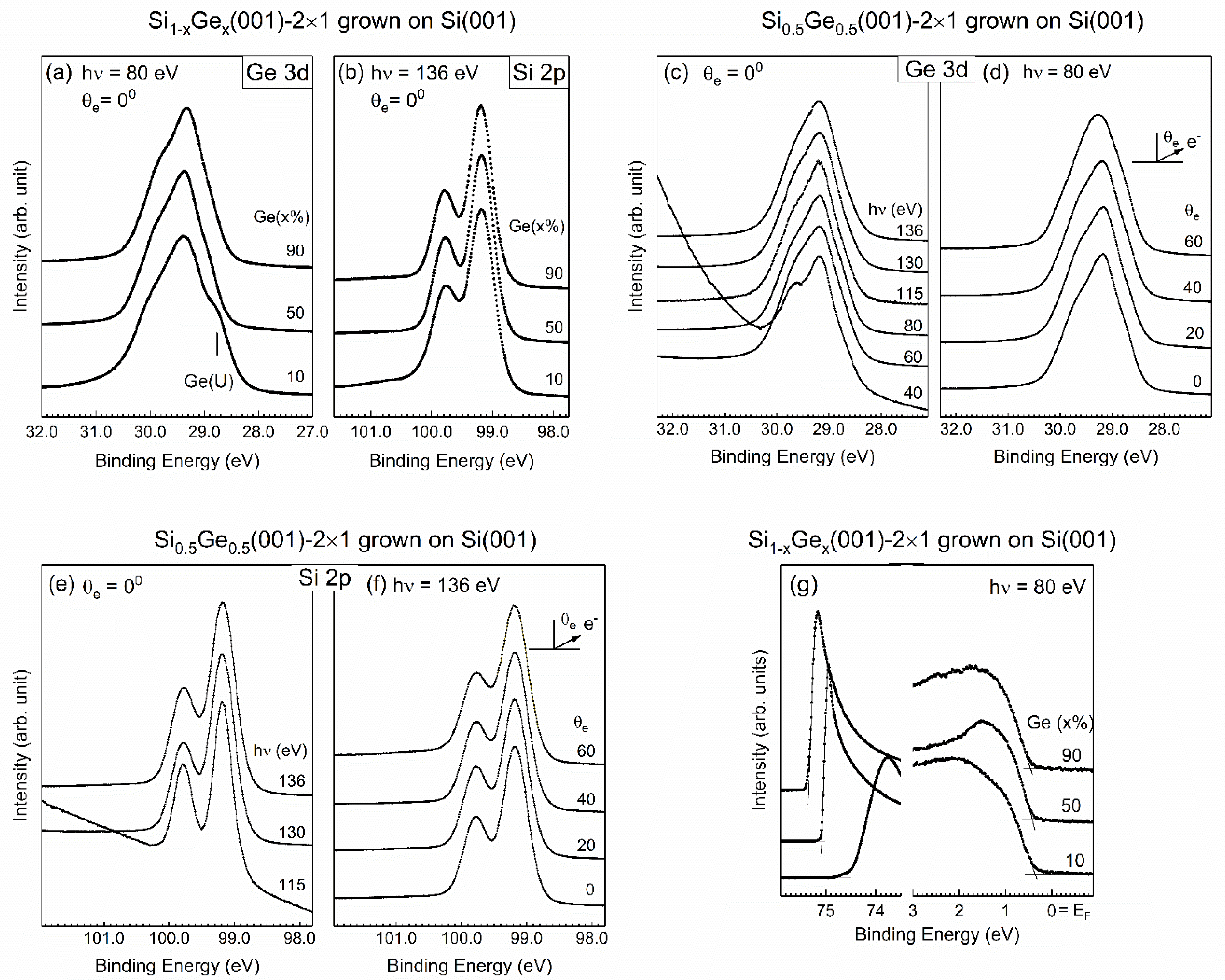

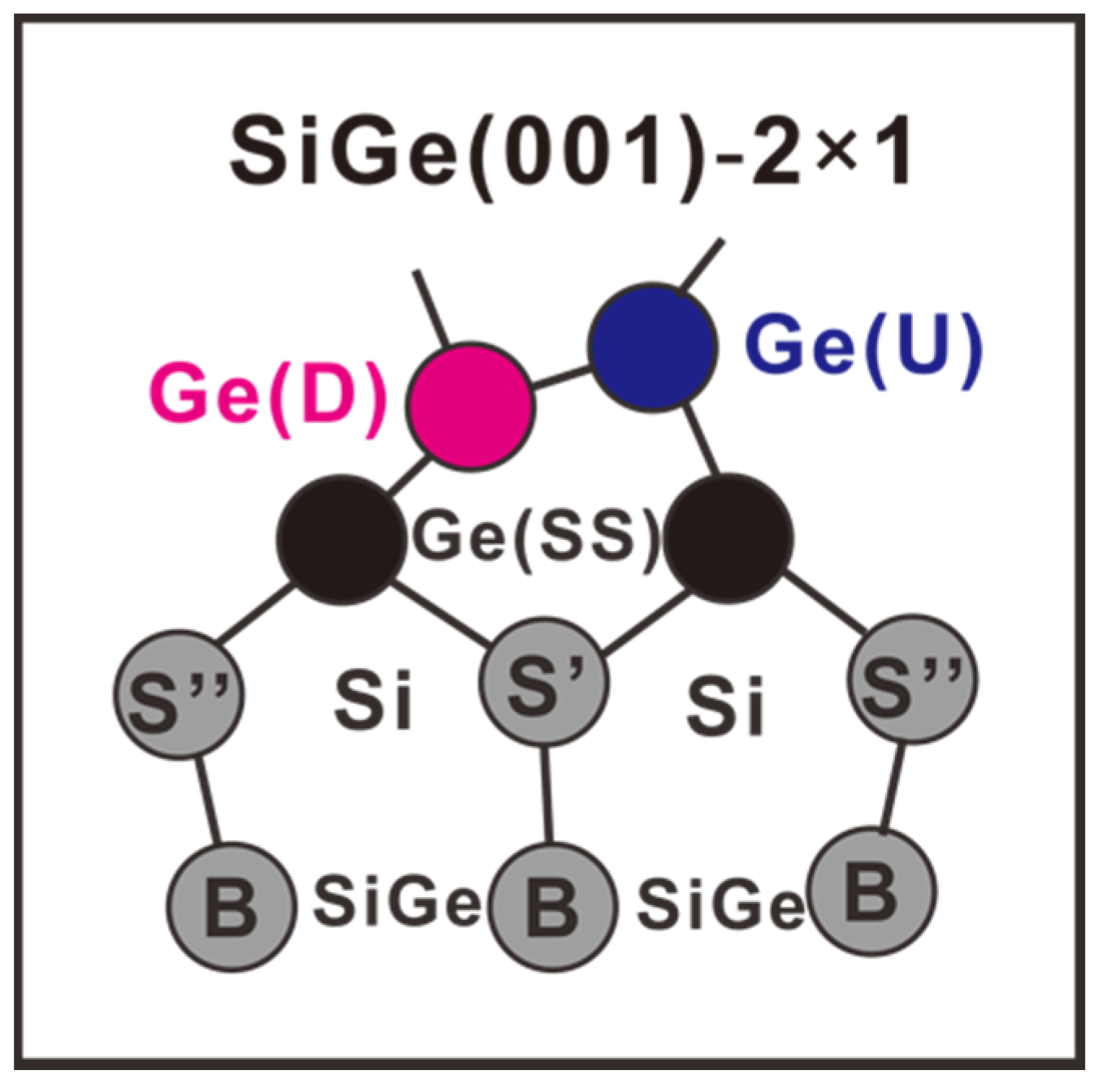
| Si(001) | x = 10% | x = 30% | x = 50% | x = 70% | x = 90% | Ge(001) | |
|---|---|---|---|---|---|---|---|
| IP (eV) (on Ge) | 5.40 | 5.32 | 5.06 | 4.90 | 5.19 | 5.04 | |
| IP (eV) (on Si) | 5.27 | 5.26 | 5.15 | 5.14 |
| x = 10% | x = 50% | x = 90% | |
|---|---|---|---|
| Ge 3d | |||
| SCLS of Ge(SS) | +0.254 | +0.269 | +0.297 |
| SCLS of Ge(U) | −0.512 | −0.405 | −0.398 |
| SCLS Ge(D) | −0.056 | −0.092 | −0.086 |
| Δ(Ge(U)-Ge(D)) | 0.456 | 0.313 | 0.312 |
| % Area (Ge(B)) | 1.3% | 28% | 38% |
| Si 2p | |||
| Δ(Si(S)’-Si(B)) | 0.120 | 0.110 | 0.132 |
| Δ(Si(S)”-Si(B)) | 0.056 | 0.116 | 0.070 |
| % Area (Si(B)) | 48% | 54% | 54% |
Publisher’s Note: MDPI stays neutral with regard to jurisdictional claims in published maps and institutional affiliations. |
© 2022 by the authors. Licensee MDPI, Basel, Switzerland. This article is an open access article distributed under the terms and conditions of the Creative Commons Attribution (CC BY) license (https://creativecommons.org/licenses/by/4.0/).
Share and Cite
Cheng, Y.-T.; Wan, H.-W.; Kwo, J.; Hong, M.; Pi, T.-W. A Synchrotron Radiation Photoemission Study of SiGe(001)-2×1 Grown on Ge and Si Substrates: The Surface Electronic Structure for Various Ge Concentrations. Nanomaterials 2022, 12, 1309. https://doi.org/10.3390/nano12081309
Cheng Y-T, Wan H-W, Kwo J, Hong M, Pi T-W. A Synchrotron Radiation Photoemission Study of SiGe(001)-2×1 Grown on Ge and Si Substrates: The Surface Electronic Structure for Various Ge Concentrations. Nanomaterials. 2022; 12(8):1309. https://doi.org/10.3390/nano12081309
Chicago/Turabian StyleCheng, Yi-Ting, Hsien-Wen Wan, Jueinai Kwo, Minghwei Hong, and Tun-Wen Pi. 2022. "A Synchrotron Radiation Photoemission Study of SiGe(001)-2×1 Grown on Ge and Si Substrates: The Surface Electronic Structure for Various Ge Concentrations" Nanomaterials 12, no. 8: 1309. https://doi.org/10.3390/nano12081309
APA StyleCheng, Y.-T., Wan, H.-W., Kwo, J., Hong, M., & Pi, T.-W. (2022). A Synchrotron Radiation Photoemission Study of SiGe(001)-2×1 Grown on Ge and Si Substrates: The Surface Electronic Structure for Various Ge Concentrations. Nanomaterials, 12(8), 1309. https://doi.org/10.3390/nano12081309





